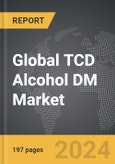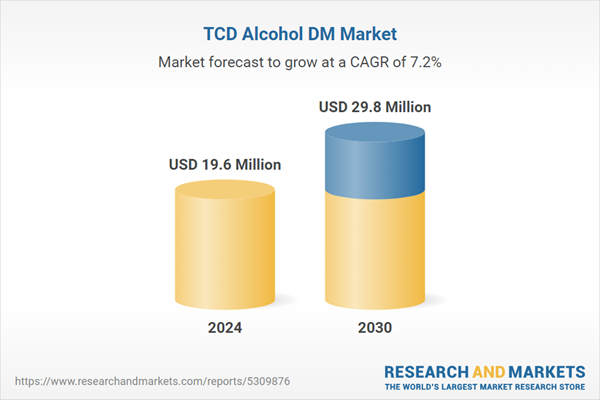Global TCD Alcohol DM Market - Key Trends & Drivers Summarized
What Is Driving the Growing Demand for TCD Alcohol DM in Specialty Chemicals?
TCD Alcohol DM, also known as tricyclodecanedimethanol, is gaining prominence within the specialty chemicals sector, particularly in applications such as personal care, coatings, adhesives, and fragrances. One of the core drivers behind its rising demand is its unique chemical structure, which offers high stability, low volatility, and compatibility with a range of compounds, making it an ideal component in various formulations. As consumers become more focused on high-performance and environmentally friendly products, manufacturers are increasingly incorporating TCD Alcohol DM into formulations to meet these preferences. Its biodegradable nature and minimal environmental footprint further boost its adoption across industries. The product is widely used in the production of specialty polymers and high-performance resins, which are essential for industries like automotive and construction, creating consistent demand.How Is Innovation Shaping the Future of TCD Alcohol DM Applications?
Innovation continues to expand the use of TCD Alcohol DM in various fields. In the coatings and adhesives industry, the compound is playing a pivotal role in the development of high-durability, low-VOC (volatile organic compounds) formulations that meet stringent environmental regulations. Additionally, the growing trend toward renewable and sustainable materials is fostering research into new production methods and applications for TCD Alcohol DM. The chemical industry is exploring ways to enhance the efficiency and yield of TCD Alcohol DM in manufacturing, making it more cost-effective. Meanwhile, emerging applications in biotechnology and pharmaceuticals are being developed due to the alcohol's ability to serve as a solvent in complex reactions, as well as its compatibility with sensitive biologics.What Are the New Consumer Trends Influencing the TCD Alcohol DM Market?
Consumer behavior is increasingly leaning toward eco-friendly and health-conscious products, a trend that directly impacts the demand for TCD Alcohol DM. In personal care products, the growing preference for natural and non-toxic ingredients is pushing manufacturers to use TCD Alcohol DM in perfumes, lotions, and hair care formulations. The product's stability and non-irritating properties make it an attractive ingredient for premium personal care brands targeting sensitive skin. Furthermore, the shift toward high-performance products in the construction and automotive sectors - where consumers demand materials that are lightweight, durable, and sustainable - drives the adoption of TCD Alcohol DM in specialty polymers and coatings. This compound's ability to contribute to long-lasting, environmentally safe formulations resonates strongly with evolving consumer preferences.The Growth in the TCD Alcohol DM Market Is Driven by Several Factors
The growth in the TCD Alcohol DM market is driven by several factors, including technological advancements in chemical manufacturing processes, which have made the production of TCD Alcohol DM more efficient and scalable. Rising environmental regulations across industries, particularly in Europe and North America, are encouraging the shift toward low-VOC and biodegradable products, further fueling demand. In addition, the increasing focus on renewable resources and sustainability is leading to the exploration of bio-based alternatives for TCD Alcohol DM, thus expanding its application range. The growing use of this compound in personal care products, coatings, and high-performance polymers is directly influenced by consumer demand for eco-friendly, high-performance solutions. As industries such as automotive, electronics, and construction continue to evolve, the demand for materials that offer superior durability, low environmental impact, and high functionality - qualities inherent in TCD Alcohol DM - continues to rise.Report Scope
The report analyzes the TCD Alcohol DM market, presented in terms of market value (US$ Thousand). The analysis covers the key segments and geographic regions outlined below.- Segments: End-Use Application (UV Cure Coating, UV Inkjet Inks, Other End-Use Applications).
- Geographic Regions/Countries:World; United States; Canada; Japan; China; Europe (France; Germany; Italy; United Kingdom; Spain; Russia; and Rest of Europe); Asia-Pacific (Australia; India; South Korea; and Rest of Asia-Pacific); Latin America (Argentina; Brazil; Mexico; and Rest of Latin America); Middle East (Iran; Israel; Saudi Arabia; United Arab Emirates; and Rest of Middle East); and Africa.
Key Insights:
- Market Growth: Understand the significant growth trajectory of the UV Cure Coating Application segment, which is expected to reach US$10.8 Million by 2030 with a CAGR of a 6.2%. The UV Inkjet Inks Application segment is also set to grow at 8% CAGR over the analysis period.
- Regional Analysis: Gain insights into the U.S. market, valued at $5.1 Million in 2024, and China, forecasted to grow at an impressive 10.5% CAGR to reach $7.1 Million by 2030. Discover growth trends in other key regions, including Japan, Canada, Germany, and the Asia-Pacific.
Why You Should Buy This Report:
- Detailed Market Analysis: Access a thorough analysis of the Global TCD Alcohol DM Market, covering all major geographic regions and market segments.
- Competitive Insights: Get an overview of the competitive landscape, including the market presence of major players across different geographies.
- Future Trends and Drivers: Understand the key trends and drivers shaping the future of the Global TCD Alcohol DM Market.
- Actionable Insights: Benefit from actionable insights that can help you identify new revenue opportunities and make strategic business decisions.
Key Questions Answered:
- How is the Global TCD Alcohol DM Market expected to evolve by 2030?
- What are the main drivers and restraints affecting the market?
- Which market segments will grow the most over the forecast period?
- How will market shares for different regions and segments change by 2030?
- Who are the leading players in the market, and what are their prospects?
Report Features:
- Comprehensive Market Data: Independent analysis of annual sales and market forecasts in US$ Million from 2024 to 2030.
- In-Depth Regional Analysis: Detailed insights into key markets, including the U.S., China, Japan, Canada, Europe, Asia-Pacific, Latin America, Middle East, and Africa.
- Company Profiles: Coverage of players such as Contimpex S.A, Eastman Chemical Company, Ernesto Ventos S.A., LLUCH ESSENCE, S.L.U, Moellhausen S.p.A. and more.
- Complimentary Updates: Receive free report updates for one year to keep you informed of the latest market developments.
Some of the 47 companies featured in this TCD Alcohol DM market report include:
- Contimpex S.A
- Eastman Chemical Company
- Ernesto Ventos S.A.
- LLUCH ESSENCE, S.L.U
- Moellhausen S.p.A.
- OQ Chemicals GmbH
- Prodasynth
- Soditas A.S.
- SynChem, Inc.
- Tokyo Chemical Industry Co., Ltd.
This edition integrates the latest global trade and economic shifts into comprehensive market analysis. Key updates include:
- Tariff and Trade Impact: Insights into global tariff negotiations across 180+ countries, with analysis of supply chain turbulence, sourcing disruptions, and geographic realignment. Special focus on 2025 as a pivotal year for trade tensions, including updated perspectives on the Trump-era tariffs.
- Adjusted Forecasts and Analytics: Revised global and regional market forecasts through 2030, incorporating tariff effects, economic uncertainty, and structural changes in globalization. Includes historical analysis from 2015 to 2023.
- Strategic Market Dynamics: Evaluation of revised market prospects, regional outlooks, and key economic indicators such as population and urbanization trends.
- Innovation & Technology Trends: Latest developments in product and process innovation, emerging technologies, and key industry drivers shaping the competitive landscape.
- Competitive Intelligence: Updated global market share estimates for 2025, competitive positioning of major players (Strong/Active/Niche/Trivial), and refined focus on leading global brands and core players.
- Expert Insight & Commentary: Strategic analysis from economists, trade experts, and domain specialists to contextualize market shifts and identify emerging opportunities.
Table of Contents
Companies Mentioned (Partial List)
A selection of companies mentioned in this report includes, but is not limited to:
- Contimpex S.A
- Eastman Chemical Company
- Ernesto Ventos S.A.
- LLUCH ESSENCE, S.L.U
- Moellhausen S.p.A.
- OQ Chemicals GmbH
- Prodasynth
- Soditas A.S.
- SynChem, Inc.
- Tokyo Chemical Industry Co., Ltd.
Table Information
| Report Attribute | Details |
|---|---|
| No. of Pages | 197 |
| Published | December 2025 |
| Forecast Period | 2024 - 2030 |
| Estimated Market Value ( USD | $ 19.6 Million |
| Forecasted Market Value ( USD | $ 29.8 Million |
| Compound Annual Growth Rate | 7.2% |
| Regions Covered | Global |









